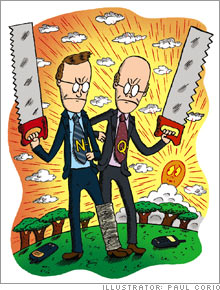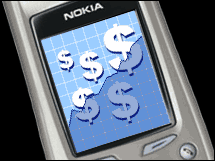Nokia battles Qualcomm over royaltiesThe handset maker wants to cut its royalty payments for using Qualcomm's technology. The outcome will have huge implications for everyone else.(Fortune Magazine) -- Six dollars might not seem like a lot of money in a $750 billion industry - but it is. That's the approximate royalty that Nokia, the world's largest handset vendor, pays on average to Qualcomm, the mobile industry's most powerful intellectual-property company, for every cell phone that Nokia sells using designs based on Qualcomm's CDMA technology. Nokia insists that it's paying way too much and is demanding a reduction when the current licensing pact expires April 9. Its reasoning: Nokia (Charts) is phasing out production of CDMA phones, and Qualcomm (Charts) technology makes up a much smaller portion of the 3G phones that are starting to fill Nokia's product stable than it did back in 1992, when it first agreed to pay royalties.
Qualcomm disagrees and is demanding that Nokia continue to pay the same royalty. Neither company will say exactly how much Nokia pays for which phones, but Qualcomm says the average it charges Nokia - and 130 other licensees - is just below 5 percent of the wholesale price of applicable phones and other devices. The two companies are locked in a bitter stalemate that shows no sign of easing by the April deadline. "Nokia is working to ensure that we are paying what is fair and reasonable and nothing more," the company's chief executive Olli-Pekka Kallasvuo told financial analysts in a conference call in late October. Nokia claims that the version of 3G it sells in Europe, called WCDMA, draws relatively little on Qualcomm's contributions. During the same call, Nokia CFO Rick Simonson noted, "We do not believe it is reasonable that the same royalty base and structure should still apply." Qualcomm is having none of it. Its president, Steve Altman, says the current royalty is valid because when Nokia and Qualcomm first agreed to it in 1992, Qualcomm had 37 relevant "patent applications," compared with about 5,100 today. Yet "we've never increased our royalty rates," he says. Many of Qualcomm's newer technologies, he adds, will help Nokia and the mobile industry march into the Internet era, in which mobile devices double as gadgets that surf the Web, send e-mails, play videos and music and make less expensive calls over the Internet. "If anything, it's quite reasonable that Nokia should pay more," says Qualcomm Europe president Andrew Gilbert. The stakes are huge. "The standoff between Nokia and Qualcomm is one of the biggest issues facing the industry now," says Ben Wood of CCS, a telecom consultancy in London. "Everyone in the industry is watching." That's because so many of the one billion handsets sold in 2006 alone are made up of multiple technologies - where one company pays another for the rights. The deal that Nokia strikes could effect terms Qualcomm agrees to with other licensees, such as handset makers Motorola (Charts) and Samsung, when they expire. Nokia sells more than 300 million phones a year, so every dollar per handset adds up fast. The company is counting on high-margin 3G multimedia phones to soften the decline in margins it is experiencing as it sells more ordinary phones into low-price markets such as China, India and Russia. Kallasvuo in November cut the company's projected operating margins to 15 percent from 17 percent, citing pricing pressure in emerging markets and an increasingly competitive networking business. The worst-case scenario for Nokia is that if the two companies don't agree by April, then Qualcomm could win an injunction stopping Nokia from selling phones with its technology. For Qualcomm, all this threatens a key business. In fiscal year 2006, which ended Sept. 24, Qualcomm clocked $2.8 billion in licensing revenue, a 45 percent surge from $1.9 billion in 2005. Licensing and royalties accounted for 37 percent of Qualcomm's $7.5 billion revenue in 2006, up from 34 percent in 2005. Qualcomm also sells chip sets, which make up 58 percent of its business. In November it warned that 2007 earnings could take a hit of up to $150 million, or 6 cents a share, if Nokia stops paying royalties, and that Qualcomm could lose rights to sell products based on Nokia technologies. With so much at stake, it's no surprise that the two companies seem miles away from reaching terms. "We're no longer optimistic we'll be able to sign an agreement by April," says Qualcomm's Altman. It's not helping that Nokia and Qualcomm are fighting each other over at least three patent-related disputes in courts from London to California. "As you know, IPR in our business environment has become increasingly important and somewhat controversial," Kallasvuo told analysts. Controversial sounds like an understatement. Then again, they're only haggling over six bucks. _______________ |
|


